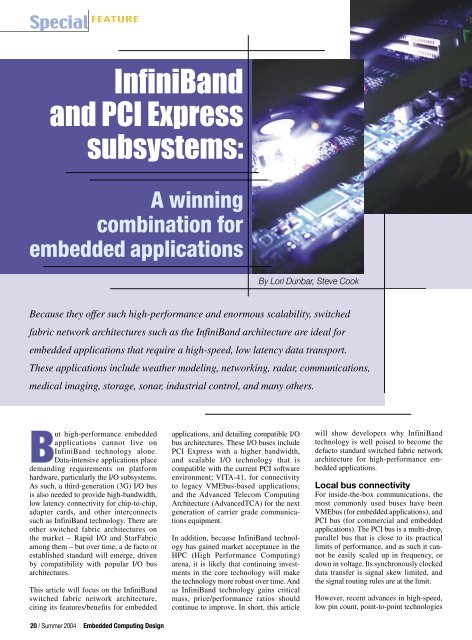Embedded Computing Design - OpenSystems Media
Embedded Computing Design - OpenSystems Media
Embedded Computing Design - OpenSystems Media
Create successful ePaper yourself
Turn your PDF publications into a flip-book with our unique Google optimized e-Paper software.
InfiniBand<br />
and PCI Express<br />
subsystems:<br />
A winning<br />
combination for<br />
embedded applications<br />
By Lori Dunbar, Steve Cook<br />
Because they offer such high-performance and enormous scalability, switched<br />
fabric network architectures such as the InfiniBand architecture are ideal for<br />
embedded applications that require a high-speed, low latency data transport.<br />
These applications include weather modeling, networking, radar, communications,<br />
medical imaging, storage, sonar, industrial control, and many others.<br />
But high-performance embedded<br />
applications cannot live on<br />
InfiniBand technology alone.<br />
Data-intensive applications place<br />
demanding requirements on platform<br />
hardware, particularly the I/O subsystems.<br />
As such, a third-generation (3G) I/O bus<br />
is also needed to provide high-bandwidth,<br />
low latency connectivity for chip-to-chip,<br />
adapter cards, and other interconnects<br />
such as InfiniBand technology. There are<br />
other switched fabric architectures on<br />
the market – Rapid I/O and StarFabric<br />
among them – but over time, a de facto or<br />
established standard will emerge, driven<br />
by compatibility with popular I/O bus<br />
architectures.<br />
This article will focus on the InfiniBand<br />
switched fabric network architecture,<br />
citing its features/benefits for embedded<br />
20 / Summer 2004 <strong>Embedded</strong> <strong>Computing</strong> <strong>Design</strong><br />
applications, and detailing compatible I/O<br />
bus architectures. These I/O buses include<br />
PCI Express with a higher bandwidth,<br />
and scalable I/O technology that is<br />
compatible with the current PCI software<br />
environment; VITA-41, for connectivity<br />
to legacy VMEbus-based applications;<br />
and the Advanced Telecom <strong>Computing</strong><br />
Architecture (AdvancedTCA) for the next<br />
generation of carrier grade communications<br />
equipment.<br />
In addition, because InfiniBand technology<br />
has gained market acceptance in the<br />
HPC (High Performance <strong>Computing</strong>)<br />
arena, it is likely that continuing investments<br />
in the core technology will make<br />
the technology more robust over time. And<br />
as InfiniBand technology gains critical<br />
mass, price/performance ratios should<br />
continue to improve. In short, this article<br />
will show developers why InfiniBand<br />
technology is well poised to become the<br />
defacto standard switched fabric network<br />
architecture for high-performance embedded<br />
applications.<br />
Local bus connectivity<br />
For inside-the-box communications, the<br />
most commonly used buses have been<br />
VMEbus (for embedded applications), and<br />
PCI bus (for commercial and embedded<br />
applications). The PCI bus is a multi-drop,<br />
parallel bus that is close to its practical<br />
limits of performance, and as such it cannot<br />
be easily scaled up in frequency, or<br />
down in voltage. Its synchronously clocked<br />
data transfer is signal skew limited, and<br />
the signal routing rules are at the limit.<br />
However, recent advances in high-speed,<br />
low pin count, point-to-point technologies
















